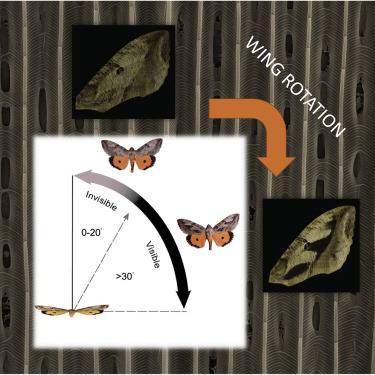Dirty Dancing in the Dark – facilitated by a nanostructure in a nocturnal moth?

In a project led by Jennifer Kelley (UWA) and Bodo Wilts (Fribourg), we’ve looked at a funky iridescence effect in a nocturnal moth, where a nanostructure facilitates an angle-dependent flicker that might (but we don’t know) be used by the insects for communication. What makes it somewhat special is the fact that the animal is nocturnal and that the effect happens on a part of the wing that is brown.
Here’s the paper, and here’s a dispatch/editorial article by Eric Warrant, from which I took the “Dirty Dancing in the Dark?” quote, and which he starts as follows: “The use of highly visible body colours as signals during courtship is well known from animals active in brighter light. Now a sexually dimorphic colouration signal has been discovered in a nocturnal moth, suggesting that visual courtship rituals might even occur at night.”

Here’s our paper’s abstract: The wings of butterflies and moths generate some of the most spectacular visual displays observed in nature. Particularly striking effects are seen when light interferes with nanostructure materials in the wing scales, generating bright, directional colors that often serve as dynamic visual signals. Structural coloration is not known in night-flying Lepidoptera, yet here we show a highly unusual form of wing coloration in a nocturnal, sexually dimorphic moth, Eudocima materna (Noctuidae). Males feature three dark wing patches on the dorsal forewings, and the apparent size of these patches strongly varies depending on the angle of the wing to the viewer. These optical special effects are generated using specialized wing scales that are tilted on the wing and behave like mirrors. At near-normal incidence of light, these “mirror scales” act as thin-film reflectors to produce a sparkly effect, but when light is incident at ∼20°–30° from normal, the reflectance spectrum is dominated by the diffuse scattering of the underlying, black melanin-containing scales, causing a shape-shifting effect. The strong sexual dimorphism in the arrangement and architecture of the scale nanostructures suggests that these patterns might function for sexual signaling. Flickering of the male’s wings would yield a flashing, supernormal visual stimulus to a viewer located 20°–30° away from the vertical, while being invisible to a viewer directly above the animal. Our findings reveal a novel use of structural coloration in nature that yields a dynamic, time-dependent achromatic optical signal that may be optimized for visual signaling in dim light.
Thanks Jennifer Kelley, Bodo Wilts, John Endler and Nikolai Tatarnic (Western Australian Museum) for integrating me in a project where I only played a relatively small role.
(The featured image is a composition using a starry night image by Danny Thompson Jr, which he kindly published under CC BY 2.0 on flickr. Click here for the original image and to check out Danny’s other photography. Thank you.)
Note also the press releases by the University of Western Australia and by Murdoch University.